
Transcribing audio recordings, whether it’s interviews, lectures, meetings, or podcasts, offers a wide range of benefits for individuals and organizations alike. From improving accessibility to enhancing productivity, transcription can be a valuable tool in various contexts. In this article, we’ll explore the benefits of transcribing audio recordings and why you should consider incorporating transcription into your workflow.
Improved Accessibility
One of the primary benefits of transcribing audio recordings is improved accessibility. Transcripts provide a text-based version of audio content, making it accessible to individuals with hearing impairments or those who prefer reading over listening. By transcribing your audio recordings, you ensure that your content is inclusive and can be enjoyed by a wider audience.
Enhanced Searchability and Discoverability
Transcripts make audio content more searchable and discoverable, both on the web and within your personal archives. Search engines can crawl and index text-based content more effectively than audio or video files, allowing your transcripts to appear in search results and attract more traffic to your website or platform. Additionally, having searchable transcripts makes it easier to locate specific information within your audio recordings, saving time and effort for both you and your audience.
Increased Comprehension and Retention
Reading along with an audio recording can improve comprehension and retention of the content. Transcripts provide a visual aid that reinforces auditory information, helping listeners follow along more effectively and grasp key concepts. Additionally, individuals who struggle to understand certain accents or dialects may find transcripts particularly helpful for clarifying unclear passages.
Facilitates Editing and Revision
Transcribing audio recordings is an essential step in the editing and revision process, especially for content creators and journalists. Having a written transcript allows you to review the content more easily, identify errors or inconsistencies, and make necessary revisions. Transcripts serve as a reference point for editing audio or video content, ensuring accuracy and consistency throughout the final product.
Enables Multimodal Learning
Transcripts support multimodal learning by providing learners with multiple modes of engagement. Some individuals may prefer reading text, while others may prefer listening to audio or watching video. By offering transcripts alongside your audio recordings, you accommodate different learning styles and preferences, allowing learners to engage with the content in the way that suits them best.
Tips for Transcribing Audio Recordings
Now that we’ve explored the benefits of transcribing audio recordings, let’s discuss some tips for transcribing effectively:
1. Use Transcription Software or Services
Consider using transcription software or services to streamline the transcription process. There are many tools available that can automatically transcribe audio recordings using speech recognition technology, saving you time and effort. However, it’s important to review and edit the transcripts for accuracy, as automated transcription may contain errors.
2. Break the Task into Manageable Chunks
Transcribing audio recordings can be a time-consuming task, so it’s helpful to break it down into smaller, more manageable chunks. Set aside dedicated time for transcribing and work in short, focused sessions to maintain concentration and avoid burnout. Pace yourself and take breaks as needed to stay fresh and alert.
3. Use Keyboard Shortcuts and Hotkeys
Familiarize yourself with keyboard shortcuts and hotkeys to speed up the transcription process. Many transcription software programs offer shortcuts for common tasks such as playback control, pausing, rewinding, and inserting timestamps. Learning these shortcuts can significantly increase your efficiency and productivity when transcribing audio recordings.
4. Proofread and Edit Carefully
After transcribing an audio recording, take the time to proofread and edit the transcript carefully. Check for spelling and grammar errors, punctuation inconsistencies, and inaccuracies in transcribed speech. It’s also a good idea to listen to the audio recording again while reviewing the transcript to ensure accuracy and completeness.
5. Consider Outsourcing or Collaborating
If you have limited time or resources, consider outsourcing the transcription task to a professional transcription service or collaborating with others to share the workload. Outsourcing transcription can be cost-effective and efficient, allowing you to focus on other aspects of your work while ensuring high-quality transcripts.
Conclusion
Transcribing audio recordings offers numerous benefits, from improving accessibility and searchability to enhancing comprehension and facilitating editing. By transcribing your audio content, you make it more inclusive, discoverable, and engaging for your audience. Whether you’re a content creator, educator, journalist, or business professional, incorporating transcription into your workflow can help you maximize the impact of your audio recordings and reach a wider audience effectively.
Need Audio Documentation Equipment in Seattle, WA?
Welcome to Efficiency, Inc.! Efficiency, Inc. is a woman-owned and -operated voice processing solutions company in Seattle that services the Pacific Northwest. We offer courtroom recording and transcription equipment and software. We also offer dictation solutions that are available for single-hand or hands-free operation. Our audio and video solutions can also help with court and interview room recordings. Since 1954, we have been providing courtroom equipment as well as voice processing solutions for a wide spectrum of businesses and organizations. Our products use the latest technologies and come with on-site or remote support, installation, and training — all provided by your Efficiency team. Call us today!
